Recent Advances in Nanostructured Perovskite Oxide Synthesis and Application for Electrocatalysis
Abstract
1. Introduction
2. Fundamentals of Perovskite Oxides for Electrocatalysis
3. Synthetic Strategies for Nanostructured Perovskites
3.1. Synthesis of Nanostructured Perovskites by the Templating Method
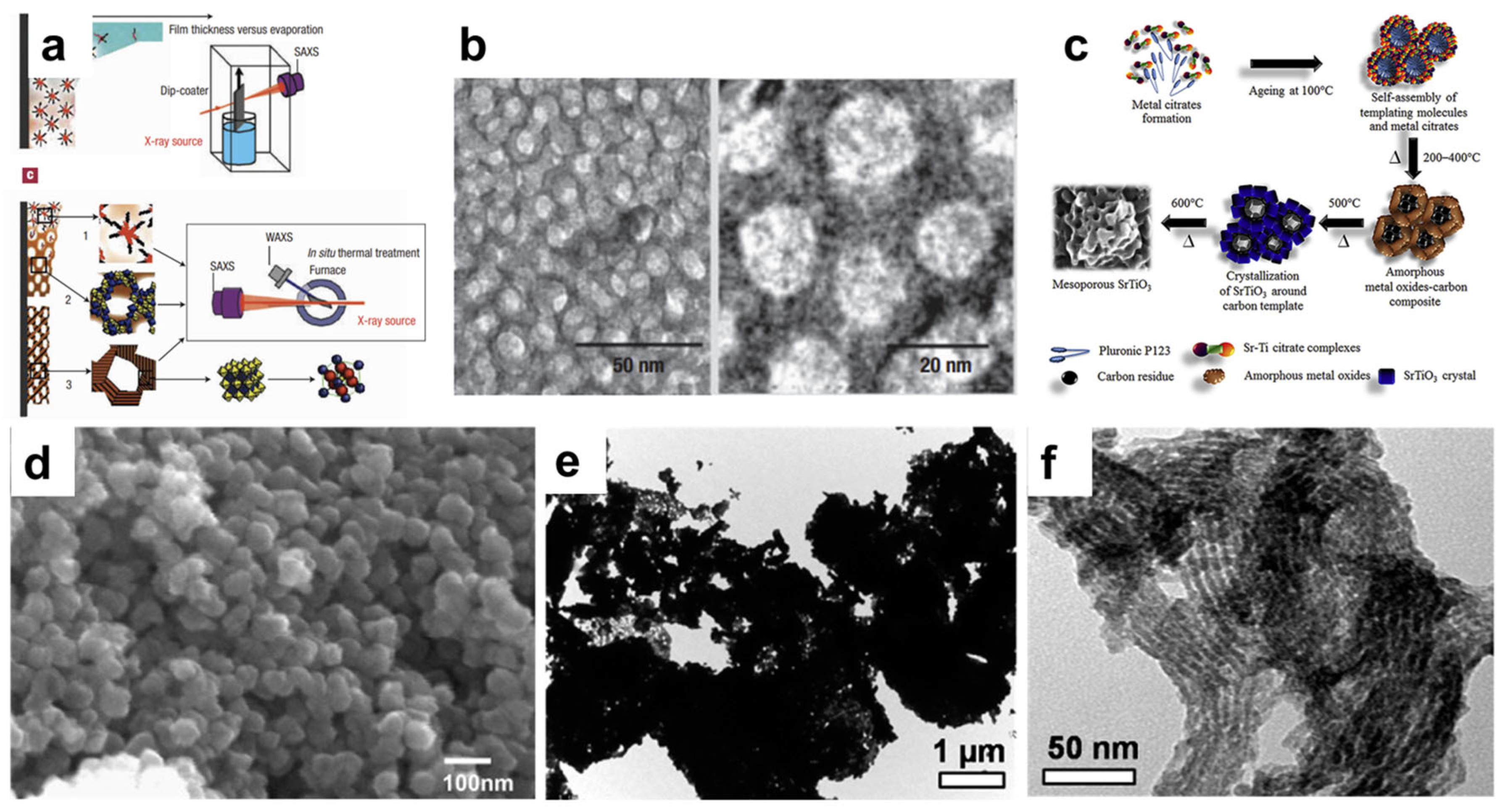
3.2. Synthesis of Nanostructured Perovskites by Hydrothermal Treatment
3.3. Synthesis of Nanostructured Perovskites by Electrospinning
3.4. Synthesis of Nanostructured Perovskites by Deposition Approaches
3.5. Evaluation of Various Synthetic Approaches
4. Application of Nanostructured Perovskite Oxides in Electrocatalytic Reactions
4.1. Nanostructured Perovskite Oxides for the Oxygen Evolution Reaction (OER)

4.2. Nanostructured Perovskite Oxides for the Hydrogen Evolution Reaction (HER)
4.3. Nanostructured Perovskite Oxides for the CO2 Reduction Reaction (CO2RR)
5. Conclusions and Outlook
Author Contributions
Funding
Conflicts of Interest
References
- Li, Z.; Fan, Q.; Yin, Y. Colloidal self-assembly approaches to smart nanostructured materials. Chem. Rev. 2021, 122, 4976–5067. [Google Scholar] [CrossRef] [PubMed]
- Ilyas, N.; Wang, J.; Li, C.; Li, D.; Fu, H.; Gu, D.; Jiang, X.; Liu, F.; Jiang, Y.; Li, W. Nanostructured materials and architectures for advanced optoelectronic synaptic devices. Adv. Funct. Mater. 2022, 32, 2110976. [Google Scholar] [CrossRef]
- Gan, Z.; Yin, J.; Xu, X.; Cheng, Y.; Yu, T. Nanostructure and advanced energy storage: Elaborate material designs lead to high-rate pseudocapacitive ion storage. ACS Nano 2022, 16, 5131–5152. [Google Scholar] [CrossRef]
- Ikram, M.; Rashid, M.; Haider, A.; Naz, S.; Haider, J.; Raza, A.; Ansar, M.; Uddin, M.K.; Ali, N.M.; Ahmed, S.S. A review of photocatalytic characterization, and environmental cleaning, of metal oxide nanostructured materials. Sustain. Mater. Technol. 2021, 30, e00343. [Google Scholar] [CrossRef]
- Lv, C.; Bai, X.; Ning, S.; Song, C.; Guan, Q.; Liu, B.; Li, Y.; Ye, J. Nanostructured materials for photothermal carbon dioxide hydrogenation: Regulating solar utilization and catalytic performance. ACS Nano 2023, 17, 1725–1738. [Google Scholar] [CrossRef] [PubMed]
- Mitchell, S.; Qin, R.; Zheng, N.; Pérez-Ramírez, J. Nanoscale engineering of catalytic materials for sustainable technologies. Nat. Nanotechnol. 2021, 16, 129–139. [Google Scholar] [CrossRef]
- Chen, X.; Shen, S.; Guo, L.; Mao, S.S. Semiconductor-based photocatalytic hydrogen generation. Chem. Rev. 2010, 110, 6503–6570. [Google Scholar]
- Cao, Y.; Liang, J.; Li, X.; Yue, L.; Liu, Q.; Lu, S.; Asiri, A.M.; Hu, J.; Luo, Y.; Sun, X. Recent advances in perovskite oxides as electrode materials for supercapacitors. Chem. Commun. 2021, 57, 2343–2355. [Google Scholar] [CrossRef]
- Wang, K.; Han, C.; Shao, Z.; Qiu, J.; Wang, S.; Liu, S. Perovskite oxide catalysts for advanced oxidation reactions. Adv. Funct. Mater. 2021, 31, 2102089. [Google Scholar] [CrossRef]
- Xu, X.; Wang, W.; Zhou, W.; Shao, Z. Recent advances in novel nanostructuring methods of perovskite electrocatalysts for energy-related applications. Small Methods 2018, 2, 1800071. [Google Scholar] [CrossRef]
- Kukovecz, A.; Kordas, K.; Kiss, J.; Konya, Z. Atomic scale characterization and surface chemistry of metal modified titanate nanotubes and nanowires. Surf. Sci. Rep. 2016, 71, 473–546. [Google Scholar]
- Liu, D.; Zhou, P.; Bai, H.; Ai, H.; Du, X.; Chen, M.; Liu, D.; Ip, W.F.; Lo, K.H.; Kwok, C.T. Development of perovskite oxide-based electrocatalysts for oxygen evolution reaction. Small 2021, 17, 2101605. [Google Scholar]
- Wang, Y.; Jiang, Y.; Zhao, Y.; Ge, X.; Lu, Q.; Zhang, T.; Xie, D.; Li, M.; Bu, Y. Design strategies of perovskite nanofibers electrocatalysts for water splitting: A mini review. Chem. Eng. J. 2023, 451, 138710. [Google Scholar]
- Zhang, H.; Xu, Y.; Lu, M.; Xie, X.; Huang, L. Perovskite oxides for cathodic electrocatalysis of energy-related gases: From O2 to CO2 and N2. Adv. Funct. Mater. 2021, 31, 2101872. [Google Scholar]
- Sun, C.; Alonso, J.A.; Bian, J. Recent advances in perovskite-type oxides for energy conversion and storage applications. Adv. Energy Mater. 2021, 11, 2000459. [Google Scholar]
- Peña, M.A.; Fierro, J. Chemical structures and performance of perovskite oxides. Chem. Rev. 2001, 101, 1981–2018. [Google Scholar] [CrossRef]
- Žužić, A.; Ressler, A.; Macan, J. Perovskite oxides as active materials in novel alternatives to well-known technologies: A review. Ceram. Int. 2022, 48, 27240–27261. [Google Scholar]
- Zhao, J.-W.; Li, Y.; Luan, D.; Lou, X.W. Structural evolution and catalytic mechanisms of perovskite oxides in electrocatalysis. Sci. Adv. 2024, 10, eadq4696. [Google Scholar]
- Ji, Q.; Bi, L.; Zhang, J.; Cao, H.; Zhao, X.S. The role of oxygen vacancies of ABO3 perovskite oxides in the oxygen reduction reaction. Energy Environ. Sci. 2020, 13, 1408–1428. [Google Scholar]
- Li, X.; Zhao, H.; Liang, J.; Luo, Y.; Chen, G.; Shi, X.; Lu, S.; Gao, S.; Hu, J.; Liu, Q. A-site perovskite oxides: An emerging functional material for electrocatalysis and photocatalysis. J. Mater. Chem. A 2021, 9, 6650–6670. [Google Scholar] [CrossRef]
- Zhu, J.; Li, H.; Zhong, L.; Xiao, P.; Xu, X.; Yang, X.; Zhao, Z.; Li, J. Perovskite oxides: Preparation, characterizations, and applications in heterogeneous catalysis. ACS Catal. 2014, 4, 2917–2940. [Google Scholar] [CrossRef]
- Navas, D.; Fuentes, S.; Castro-Alvarez, A.; Chavez-Angel, E. Review on sol-gel synthesis of perovskite and oxide nanomaterials. Gels 2021, 7, 275. [Google Scholar] [CrossRef] [PubMed]
- Zhu, X.; Liu, Z.; Ming, N. Perovskite oxide nanotubes: Synthesis, structural characterization, properties and applications. J. Mater. Chem. 2010, 20, 4015–4030. [Google Scholar] [CrossRef]
- Walton, R.I. Perovskite oxides prepared by hydrothermal and solvothermal synthesis: A review of crystallisation, chemistry, and compositions. Chem. Eur. J. 2020, 26, 9041–9069. [Google Scholar] [CrossRef]
- Grosso, D.; Boissière, C.; Smarsly, B.; Brezesinski, T.; Pinna, N.; Albouy, P.A.; Amenitsch, H.; Antonietti, M.; Sanchez, C. Periodically ordered nanoscale islands and mesoporous films composed of nanocrystalline multimetallic oxides. Nat. Mater. 2004, 3, 787–792. [Google Scholar] [CrossRef] [PubMed]
- Reitz, C.; Brezesinski, K.; Haetge, J.; Perlich, J.; Brezesinski, T. Nanocrystalline NaTaO3 thin film materials with ordered 3D mesoporous and nanopillar-like structures through PIB-b-PEO polymer templating: Towards high-performance UV-light photocatalysts. RSC Adv. 2012, 2, 5130–5133. [Google Scholar] [CrossRef]
- Reitz, C.; Suchomski, C.; Weidmann, C.; Brezesinski, T. Block copolymer-templated BiFeO3 nanoarchitectures composed of phase-pure crystallites intermingled with a continuous mesoporosity: Effective visible-light photocatalysts? Nano Res. 2011, 4, 414–424. [Google Scholar] [CrossRef]
- Suzuki, N.; Jiang, X.; Salunkhe, R.R.; Osada, M.; Yamauchi, Y. Chemical Preparation of Ferroelectric Mesoporous Barium Titanate Thin Films: Drastic Enhancement of Curie Temperature Induced by Mesopore-Derived Strain. Chem. Eur. J. 2014, 20, 11283–11286. [Google Scholar] [CrossRef]
- Lertpanyapornchai, B.; Yokoi, T.; Ngamcharussrivichai, C. Citric acid as complexing agent in synthesis of mesoporous strontium titanate via neutral-templated self-assembly sol–gel combustion method. Microporous Mesoporous Mater. 2016, 226, 505–509. [Google Scholar] [CrossRef]
- Hou, R.Z.; Ferreira, P.; Vilarinho, P.M. A facile route for synthesis of mesoporous barium titanate crystallites. Microporous Mesoporous Mater. 2008, 110, 392–396. [Google Scholar] [CrossRef]
- Li, Z.-X.; Shi, F.-B.; Ding, Y.; Zhang, T.; Yan, C.-H. Facile Synthesis of Highly Ordered Mesoporous ZnTiO3 with Crystalline Walls by Self-Adjusting Method. Langmuir 2011, 27, 14589–14593. [Google Scholar] [PubMed]
- Arandiyan, H.; Wang, Y.; Sun, H.; Rezaei, M.; Dai, H. Ordered meso- and macroporous perovskite oxide catalysts for emerging applications. Chem. Commun. 2018, 54, 6484–6502. [Google Scholar]
- Ren, Y.; Ma, Z.; Bruce, P.G. Ordered mesoporous metal oxides: Synthesis and applications. Chem. Soc. Rev. 2012, 41, 4909–4927. [Google Scholar]
- Zhang, R.; Li, P.; Liu, N.; Yue, W.; Chen, B. Effect of hard-template residues of the nanocasted mesoporous LaFeO3 with extremely high surface areas on catalytic behaviors for methyl chloride oxidation. J. Mater. Chem. A 2014, 2, 17329–17340. [Google Scholar]
- Wang, Y.; Cui, X.; Li, Y.; Chen, L.; Shu, Z.; Chen, H.; Shi, J. High surface area mesoporous LaFexCo1−xO3 oxides: Synthesis and electrocatalytic property for oxygen reduction. Dalton Trans. 2013, 42, 9448–9452. [Google Scholar] [PubMed]
- Wang, Y.; Ren, J.; Wang, Y.; Zhang, F.; Liu, X.; Guo, Y.; Lu, G. Nanocasted Synthesis of Mesoporous LaCoO3 Perovskite with Extremely High Surface Area and Excellent Activity in Methane Combustion. J. Phys. Chem. C 2008, 112, 15293–15298. [Google Scholar]
- Nair, M.M.; Kleitz, F.; Kaliaguine, S. Kinetics of Methanol Oxidation over Mesoporous Perovskite Catalysts. ChemCatChem 2012, 4, 387–394. [Google Scholar]
- Nair, M.M.; Kaliaguine, S.; Kleitz, F. Nanocast LaNiO3 Perovskites as Precursors for the Preparation of Coke-Resistant Dry Reforming Catalysts. ACS Catal. 2014, 4, 3837–3846. [Google Scholar]
- de Lima, R.K.C.; Batista, M.S.; Wallau, M.; Sanches, E.A.; Mascarenhas, Y.P.; Urquieta-González, E.A. High specific surface area LaFeCo perovskites—Synthesis by nanocasting and catalytic behavior in the reduction of NO with CO. Appl. Catal. B 2009, 90, 441–450. [Google Scholar]
- Zhang, C.; Zhang, W.; Li, X.; Zhu, Z.; Wang, Q.; Luo, S.; Xie, A. Honeycomb LaMnO3 Perovskite Synthesized by a Carbon Sphere as a Self-Sacrificing Template for Supercapacitors. Energy Fuels 2021, 35, 13457–13465. [Google Scholar]
- Zhang, C.; Yu, D.; Peng, C.; Wang, L.; Yu, X.; Wei, Y.; Liu, J.; Zhao, Z. Research progress on preparation of 3DOM-based oxide catalysts and their catalytic performances for the combustion of diesel soot particles. Appl. Catal. B 2022, 319, 121946. [Google Scholar] [CrossRef]
- Zhang, C.; Zhao, P.; Liu, S.; Yu, K. Three-dimensionally ordered macroporous perovskite materials for environmental applications. Chin. J. Catal. 2019, 40, 1324–1338. [Google Scholar]
- Chi, E.O.; Kim, Y.N.; Kim, J.C.; Hur, N.H. A Macroporous Perovskite Manganite from Colloidal Templates with a Curie Temperature of 320 K. Chem. Mater. 2003, 15, 1929–1931. [Google Scholar]
- Ji, K.; Dai, H.; Deng, J.; Jiang, H.; Zhang, L.; Zhang, H.; Cao, Y. Catalytic removal of toluene over three-dimensionally ordered macroporous Eu1–xSrxFeO3. Chem. Eng. J. 2013, 214, 262–271. [Google Scholar]
- Zhao, Z.; Dai, H.; Deng, J.; Du, Y.; Liu, Y.; Zhang, L. Three-dimensionally ordered macroporous La0.6Sr0.4FeO3−δ: High-efficiency catalysts for the oxidative removal of toluene. Microporous Mesoporous Mater. 2012, 163, 131–139. [Google Scholar]
- Xu, J.; Liu, J.; Zhao, Z.; Zheng, J.; Zhang, G.; Duan, A.; Jiang, G. Three-dimensionally ordered macroporous LaCoxFe1−xO3 perovskite-type complex oxide catalysts for diesel soot combustion. Catal. Today 2010, 153, 136–142. [Google Scholar]
- Kim, Y.N.; Kim, S.J.; Lee, E.K.; Chi, E.O.; Hur, N.H.; Hong, C.S. Large magnetoresistance in three dimensionally ordered macroporous perovskite manganites prepared by a colloidal templating method. J. Mater. Chem. 2004, 14, 1774–1777. [Google Scholar]
- Shen, Y.; Zhao, K.; He, F.; Li, H.-B. Synthesis of three-dimensionally ordered macroporous LaFe0.7Co0.3O3 perovskites and their performance for chemical-looping steam reforming of methane. Fuel Chem. Technol. 2016, 44, 1168–1176. [Google Scholar]
- Sadakane, M.; Asanuma, T.; Kubo, J.; Ueda, W. Facile Procedure to Prepare Three-Dimensionally Ordered Macroporous (3DOM) Perovskite-type Mixed Metal Oxides by Colloidal Crystal Templating Method. Chem. Mater. 2005, 17, 3546–3551. [Google Scholar]
- Wang, Y.; Arandiyan, H.; Tahini, H.A.; Scott, J.; Tan, X.; Dai, H.; Gale, J.D.; Rohl, A.L.; Smith, S.C.; Amal, R. The controlled disassembly of mesostructured perovskites as an avenue to fabricating high performance nanohybrid catalysts. Nat. Commun. 2017, 8, 15553. [Google Scholar]
- Modeshia, D.R.; Walton, R.I. Solvothermal synthesis of perovskites and pyrochlores: Crystallisation of functional oxides under mild conditions. Chem. Soc. Rev. 2010, 39, 4303–4325. [Google Scholar] [PubMed]
- Xu, G.; Ren, Z.; Du, P.; Weng, W.; Shen, G.; Han, G. Polymer-assisted hydrothermal synthesis of single-crystalline tetragonal perovskite PbZr0.52Ti0.48O3 nanowires. Adv. Mater. 2005, 17, 907–910. [Google Scholar]
- Zhang, J.; Zhao, Y.; Zhao, X.; Liu, Z.; Chen, W. Porous Perovskite LaNiO3 Nanocubes as Cathode Catalysts for Li-O2 Batteries with Low Charge Potential. Sci. Rep. 2014, 4, 6005. [Google Scholar]
- Kim, J.; Chen, X.; Shih, P.-C.; Yang, H. Porous Perovskite-Type Lanthanum Cobaltite as Electrocatalysts toward Oxygen Evolution Reaction. ACS Sustain. Chem. Eng. 2017, 5, 10910–10917. [Google Scholar]
- Ge, X.; Goh, F.W.T.; Li, B.; Hor, T.S.A.; Zhang, J.; Xiao, P.; Wang, X.; Zong, Y.; Liu, Z. Efficient and durable oxygen reduction and evolution of a hydrothermally synthesized La(Co0.55Mn0.45)0.99O3−δ nanorod/graphene hybrid in alkaline media. Nanoscale 2015, 7, 9046–9054. [Google Scholar]
- Ogunniran, K.O.; Murugadoss, G.; Thangamuthu, R.; Periasamy, P. Evaluation of nanostructured Nd0.7Co0.3FeO3 perovskite obtained via hydrothermal method as anode material for Li-ion battery. Mater. Chem. Phys. 2020, 248, 122944. [Google Scholar]
- Chen, X.; Chen, S.; Nan, B.; Jia, F.; Lu, Z.; Deng, H. In situ, facile synthesis of La0.8Sr0.2MnO3/nitrogen-doped graphene: A high-performance catalyst for rechargeable Li-O2 batteries. Ionics 2017, 23, 2241–2250. [Google Scholar]
- Thanh, T.D.; Chuong, N.D.; Balamurugan, J.; Van Hien, H.; Kim, N.H.; Lee, J.H. Porous Hollow-Structured LaNiO3 Stabilized N,S-Codoped Graphene as an Active Electrocatalyst for Oxygen Reduction Reaction. Small 2017, 13, 1701884. [Google Scholar]
- Hu, J.; Liu, Q.; Shi, Z.; Zhang, L.; Huang, H. LaNiO3-nanorod/graphene composite as an efficient bi-functional catalyst for zinc–air batteries. RSC Adv. 2016, 6, 86386–86394. [Google Scholar] [CrossRef]
- Xu, G.; Deng, S.; Zhang, Y.; Wei, X.; Yang, X.; Liu, Y.; Shen, G.; Han, G. Mesoporous-structure-tailored hydrothermal synthesis and mechanism of the SrTiO3 mesoporous spheres by controlling the silicate semipermeable membranes with the KOH concentrations. CrystEngComm 2014, 16, 2025–2031. [Google Scholar]
- Ma, T.-Y.; Li, H.; Ren, T.-Z.; Yuan, Z.-Y. Mesoporous SrTiO3 nanowires from a template-free hydrothermal process. RSC Adv. 2012, 2, 2790–2796. [Google Scholar] [CrossRef]
- Pan, J.H.; Shen, C.; Ivanova, I.; Zhou, N.; Wang, X.; Tan, W.C.; Xu, Q.-H.; Bahnemann, D.W.; Wang, Q. Self-Template Synthesis of Porous Perovskite Titanate Solid and Hollow Submicrospheres for Photocatalytic Oxygen Evolution and Mesoscopic Solar Cells. ACS Appl. Mater. Interfaces 2015, 7, 14859–14869. [Google Scholar] [CrossRef] [PubMed]
- Qiu, H.; Cheng, H.; Li, G.; Li, Q.; Chen, S. Electrospinning-chemistry strategy for self-supporting perovskite oxide fabric electrodes towards high-capacitance supercapacitors. Mater. Lett. 2022, 320, 132322. [Google Scholar] [CrossRef]
- Park, H.W.; Lee, D.U.; Zamani, P.; Seo, M.H.; Nazar, L.F.; Chen, Z. Electrospun porous nanorod perovskite oxide/nitrogen-doped graphene composite as a bi-functional catalyst for metal air batteries. Nano Energy 2014, 10, 192–200. [Google Scholar] [CrossRef]
- Zhen, D.; Zhao, B.; Shin, H.-C.; Bu, Y.; Ding, Y.; He, G.; Liu, M. Electrospun Porous Perovskite La0.6Sr0.4Co1–xFexO3–δ Nanofibers for Efficient Oxygen Evolution Reaction. Adv. Mater. Interfaces 2017, 4, 1700146. [Google Scholar] [CrossRef]
- Li, X.; Zhang, Y.; Zhang, L.; Xia, S.; Zhao, Y.; Yan, J.; Yu, J.; Ding, B. Synthesizing Superior Flexible Oxide Perovskite Ceramic Nanofibers by Precisely Controlling Crystal Nucleation and Growth. Small 2022, 18, 2106500. [Google Scholar] [CrossRef]
- Qin, C.; Li, Z.; Chen, G.; Zhao, Y.; Lin, T. Fabrication and visible-light photocatalytic behavior of perovskite praseodymium ferrite porous nanotubes. J. Power Sources 2015, 285, 178–184. [Google Scholar] [CrossRef]
- Chen, C.; Li, W.; Cao, C.; Song, W. Enhanced catalytic activity of perovskite oxide nanofibers for combustion of methane in coal mine ventilation air. J. Mater. Chem. 2010, 20, 6968–6974. [Google Scholar] [CrossRef]
- Hildebrandt, N.C.; Soldat, J.; Marschall, R. Layered Perovskite Nanofibers via Electrospinning for Overall Water Splitting. Small 2015, 11, 2051–2057. [Google Scholar] [CrossRef]
- Bu, Y.; Gwon, O.; Nam, G.; Jang, H.; Kim, S.; Zhong, Q.; Cho, J.; Kim, G. A Highly Efficient and Robust Cation Ordered Perovskite Oxide as a Bifunctional Catalyst for Rechargeable Zinc-Air Batteries. ACS Nano 2017, 11, 11594–11601. [Google Scholar] [CrossRef]
- Zhou, J.; Wang, Y.; Zhang, D.; Zhong, D.; Liu, T.; Ding, M. Electrospun 3D structured double perovskite oxide PrBa0.8Ca0.2Co2O5+δ bifunctional electrocatalyst for zinc-air battery. J. Am. Ceram. Soc. 2024, 107, 3265–3276. [Google Scholar] [CrossRef]
- Risch, M.; Stoerzinger, K.A.; Maruyama, S.; Hong, W.T.; Takeuchi, I.; Shao-Horn, Y. La0.8Sr0.2MnO3−δ Decorated with Ba0.5Sr0.5Co0.8Fe0.2O3−δ: A Bifunctional Surface for Oxygen Electrocatalysis with Enhanced Stability and Activity. J. Am. Chem. Soc. 2014, 136, 5229–5232. [Google Scholar] [CrossRef] [PubMed]
- Liang, F.; Yang, J.; Zhao, Y.; Zhou, Y.; Yan, Z.; He, J.; Yuan, Q.; Wu, J.; Liu, P.; Zhong, Z. A review of thin film electrolytes fabricated by physical vapor deposition for solid oxide fuel cells. Int. J. Hydrogen Energy 2022, 47, 36926–36952. [Google Scholar] [CrossRef]
- Sun, Y.; Yang, J.; Li, S.; Wang, D. Defect engineering in perovskite oxide thin films. Chem. Commun. 2021, 57, 8402–8420. [Google Scholar] [CrossRef] [PubMed]
- Tian, M.; Xu, L.; Yang, Y. Perovskite oxide ferroelectric thin films. Adv. Electron. Mater. 2022, 8, 2101409. [Google Scholar] [CrossRef]
- Chen, Y.; Cai, Z.; Kuru, Y.; Ma, W.; Tuller, H.L.; Yildiz, B. Electronic Activation of Cathode Superlattices at Elevated Temperatures—Source of Markedly Accelerated Oxygen Reduction Kinetics. Adv. Energy Mater. 2013, 3, 1221–1229. [Google Scholar] [CrossRef]
- Chen, G.; Zhou, W.; Guan, D.; Sunarso, J.; Zhu, Y.; Hu, X.; Zhang, W.; Shao, Z. Two orders of magnitude enhancement in oxygen evolution reactivity on amorphous Ba0.5Sr0.5Co0.8Fe0.2O3−δ, nanofilms with tunable oxidation state. Sci. Adv. 2017, 3, e1603206. [Google Scholar] [CrossRef]
- Kalinina, E.; Pikalova, E. Opportunities, challenges and prospects for electrodeposition of thin-film functional layers in solid oxide fuel cell technology. Materials 2021, 14, 5584. [Google Scholar] [CrossRef]
- Jin, Z.; Bard, A.J. Surface Interrogation of Electrodeposited MnOx and CaMnO3 Perovskites by Scanning Electrochemical Microscopy: Probing Active Sites and Kinetics for the Oxygen Evolution Reaction. Angew. Chem. Int. Ed. 2021, 60, 794–799. [Google Scholar] [CrossRef]
- Zhang, X.; You, P.; Luo, M.; Zeng, C. Preparation of La-Cr Perovskite Coating Using Electrodeposition Method. J. Electrochem. Soc. 2016, 163, D821. [Google Scholar] [CrossRef]
- Park, B.; Song, R.; Lee, S.; Lim, T.; Park, S.; Park, C.; Lee, J. A perovskite-type lanthanum cobaltite thin film synthesized via an electrochemical route and its application in SOFC interconnects. J. Electrochem. Soc. 2015, 162, F1549. [Google Scholar]
- Therese, G.H.A.; Dinamani, M.; Kamath, P.V. Electrochemical synthesis of perovskite oxides. J. Appl. Electrochem. 2005, 35, 459–465. [Google Scholar]
- Kiran, G.K. Electrodeposition and structural characterization of MCrO3 (M = La, Pr, Nd, Gd, Dy and Y) perovskite oxide coatings on stainless steel substrates. Mater. Chem. Phys. 2021, 267, 124677. [Google Scholar]
- Li, B.-Q.; Tang, C.; Wang, H.-F.; Zhu, X.-L.; Zhang, Q. An aqueous preoxidation method for monolithic perovskite electrocatalysts with enhanced water oxidation performance. Sci. Adv. 2016, 2, e1600495. [Google Scholar] [PubMed]
- Tee, S.Y.; Win, K.Y.; Teo, W.S.; Koh, L.D.; Liu, S.; Teng, C.P.; Han, M.Y. Recent progress in energy-driven water splitting. Adv. Sci. 2017, 4, 1600337. [Google Scholar]
- Woldu, A.R.; Huang, Z.; Zhao, P.; Hu, L.; Astruc, D. Electrochemical CO2 reduction (CO2RR) to multi-carbon products over copper-based catalysts. Coord. Chem. Rev. 2022, 454, 214340. [Google Scholar]
- Leite, M.; Janáky, C.; Choi, N.-S. Energy Spotlight. ACS Energy Lett. 2020, 5, 2454–2455. [Google Scholar] [CrossRef]
- Zhang, K.; Zou, R. Advanced transition metal-based OER electrocatalysts: Current status, opportunities, and challenges. Small 2021, 17, 2100129. [Google Scholar]
- Zeng, F.; Mebrahtu, C.; Liao, L.; Beine, A.K.; Palkovits, R. Stability and deactivation of OER electrocatalysts: A review. J. Energy Chem. 2022, 69, 301–329. [Google Scholar]
- Wang, X.; Zhong, H.; Xi, S.; Lee, W.S.V.; Xue, J. Understanding of oxygen redox in the oxygen evolution reaction. Adv. Mater. 2022, 34, 2107956. [Google Scholar]
- Qiao, C.; Hao, Y.; Cao, C.; Zhang, J. Transformation mechanism of high-valence metal sites for the optimization of Co-and Ni-based OER catalysts in an alkaline environment: Recent progress and perspectives. Nanoscale 2023, 15, 450–460. [Google Scholar] [CrossRef] [PubMed]
- Li, H.; Lin, Y.; Duan, J.; Wen, Q.; Liu, Y.; Zhai, T. Stability of electrocatalytic OER: From principle to application. Chem. Soc. Rev. 2024, 53, 10709–10740. [Google Scholar] [PubMed]
- Wang, C.; Jin, L.; Shang, H.; Xu, H.; Shiraishi, Y.; Du, Y. Advances in engineering RuO2 electrocatalysts towards oxygen evolution reaction. Chin. Chem. Lett. 2021, 32, 2108–2116. [Google Scholar]
- Li, H.; Xu, Y.; Lv, N.; Zhang, Q.; Zhang, X.; Wei, Z.; Wang, Y.; Tang, H.; Pan, H. Ti-doped SnO2 supports IrO2 electrocatalysts for the oxygen evolution reaction (OER) in PEM water electrolysis. ACS Sustain. Chem. Eng. 2023, 11, 1121–1132. [Google Scholar]
- Kubba, D.; Ahmed, I.; Kour, P.; Biswas, R.; Kaur, H.; Yadav, K.; Haldar, K.K. LaCoO3 Perovskite Nanoparticles Embedded in NiCo2O4 Nanoflowers as Electrocatalysts for Oxygen Evolution. ACS Appl. Nano Mater. 2022, 5, 16344–16353. [Google Scholar]
- Sheikh, Z.A.; Vikraman, D.; Kim, H.; Aftab, S.; Shaikh, S.F.; Shahzad, F.; Jung, J.; Kim, H.-S.; Hussain, S.; Kim, D.-K. Perovskite oxide-based nanoparticles embedded MXene composites for supercapacitors and oxygen evolution reactions. J. Energy Storage 2024, 81, 110342. [Google Scholar] [CrossRef]
- Kim, H.J.; Kim, S.H.; Kim, S.-W.; Kim, J.-K.; Cao, C.; Kim, Y.; Kim, U.; Lee, G.; Choi, J.-Y.; Oh, H.-S.; et al. Low-temperature crystallization of LaFeO3 perovskite with inherent catalytically surface for the enhanced oxygen evolution reaction. Nano Energy 2023, 105, 108003. [Google Scholar]
- You, M.; Gui, L.; Ma, X.; Wang, Z.; Xu, Y.; Zhang, J.; Sun, J.; He, B.; Zhao, L. Electronic tuning of SrIrO3 perovskite nanosheets by sulfur incorporation to induce highly efficient and long-lasting oxygen evolution in acidic media. Appl. Catal. B 2021, 298, 120562. [Google Scholar]
- Li, Q.; Wu, J.; Wu, T.; Jin, H.; Zhang, N.; Li, J.; Liang, W.; Liu, M.; Huang, L.; Zhou, J. Phase Engineering of Atomically Thin Perovskite Oxide for Highly Active Oxygen Evolution. Adv. Funct. Mater. 2021, 31, 2102002. [Google Scholar]
- Liu, S.; Zhang, Y.; Mao, X.; Li, L.; Zhang, Y.; Li, L.; Pan, Y.; Li, X.; Wang, L.; Shao, Q.; et al. Ultrathin perovskite derived Ir-based nanosheets for high-performance electrocatalytic water splitting. Energy Environ. Sci. 2022, 15, 1672–1681. [Google Scholar]
- Yang, L.; Zhang, K.; Chen, H.; Shi, L.; Liang, X.; Wang, X.; Liu, Y.; Feng, Q.; Liu, M.; Zou, X. An ultrathin two-dimensional iridium-based perovskite oxide electrocatalyst with highly efficient {001} facets for acidic water oxidation. J. Energy Chem. 2022, 66, 619–627. [Google Scholar] [CrossRef]
- Zhao, T.; Wang, Y.; Chen, X.; Li, Y.; Su, Z.; Zhao, C. Vertical Growth of Porous Perovskite Nanoarrays on Nickel Foam for Efficient Oxygen Evolution Reaction. ACS Sustain. Chem. Eng. 2020, 8, 4863–4870. [Google Scholar] [CrossRef]
- Petrie, J.R.; Cooper, V.R.; Freeland, J.W.; Meyer, T.L.; Zhang, Z.; Lutterman, D.A.; Lee, H.N. Enhanced bifunctional oxygen catalysis in strained LaNiO3 perovskites. J. Am. Chem. Soc. 2016, 138, 2488–2491. [Google Scholar] [CrossRef] [PubMed]
- Tang, L.; Fan, T.; Chen, Z.; Tian, J.; Guo, H.; Peng, M.; Zuo, F.; Fu, X.; Li, M.; Bu, Y.; et al. Binary-dopant promoted lattice oxygen participation in OER on cobaltate electrocatalyst. Chem. Eng. J. 2021, 417, 129324. [Google Scholar] [CrossRef]
- Shin, S.; Kwon, T.; Kim, K.; Kim, M.; Kim, M.H.; Lee, Y. Single-Phase Perovskite SrIrO3 Nanofibers as a Highly Efficient Electrocatalyst for a pH-Universal Oxygen Evolution Reaction. ACS Appl. Energy Mater. 2022, 5, 6146–6154. [Google Scholar] [CrossRef]
- Li, Z.; Xue, K.-H.; Wang, J.; Li, J.-G.; Ao, X.; Sun, H.; Song, X.; Lei, W.; Cao, Y.; Wang, C. Cation and Anion Co-doped Perovskite Nanofibers for Highly Efficient Electrocatalytic Oxygen Evolution. ACS Appl. Mater. Interfaces 2020, 12, 41259–41268. [Google Scholar] [CrossRef]
- Li, L.; Zheng, Z.; Li, J.; Mu, Y.; Wang, Y.; Huang, Z.; Xiao, Y.; Huang, H.; Wang, S.; Chen, G.; et al. A Porous Perovskite Nanofiber with Reinforced Aerophobicity for High-Performance Anion Exchange Membrane Water Splitting. Small 2023, 19, 2301261. [Google Scholar] [CrossRef]
- Boonlha, S.; Chakthranont, P.; Kityakarn, S. 3DOM Cerium Doped LaCoO3 Bifunctional Electrocatalysts for the Oxygen Evolution and Reduction Reactions. ChemCatChem 2022, 14, e202101398. [Google Scholar] [CrossRef]
- Dai, J.; Zhu, Y.; Zhong, Y.; Miao, J.; Lin, B.; Zhou, W.; Shao, Z. Enabling High and Stable Electrocatalytic Activity of Iron-Based Perovskite Oxides for Water Splitting by Combined Bulk Doping and Morphology Designing. Adv. Mater. Interfaces 2019, 6, 1801317. [Google Scholar] [CrossRef]
- Zhou, F.; Zhou, Y.; Liu, G.-G.; Wang, C.-T.; Wang, J. Recent advances in nanostructured electrocatalysts for hydrogen evolution reaction. Rare Met. 2021, 40, 3375–3405. [Google Scholar] [CrossRef]
- Zhao, G.; Rui, K.; Dou, S.X.; Sun, W. Heterostructures for Electrochemical Hydrogen Evolution Reaction: A Review. Adv. Funct. Mater. 2018, 28, 1803291. [Google Scholar]
- Strmcnik, D.; Lopes, P.P.; Genorio, B.; Stamenkovic, V.R.; Markovic, N.M. Design principles for hydrogen evolution reaction catalyst materials. Nano Energy 2016, 29, 29–36. [Google Scholar]
- Hansen, J.N.; Prats, H.; Toudahl, K.K.; Secher, N.M.; Chan, K.; Kibsgaard, J.; Chorkendorff, I. Is there anything better than Pt for HER? ACS Energy Lett. 2021, 6, 1175–1180. [Google Scholar]
- Xu, X.; Chen, Y.; Zhou, W.; Zhu, Z.; Su, C.; Liu, M.; Shao, Z. A perovskite electrocatalyst for efficient hydrogen evolution reaction. Adv. Mater. 2016, 28, 6442–6448. [Google Scholar] [PubMed]
- Zhu, Y.; Zhou, W.; Zhong, Y.; Bu, Y.; Chen, X.; Zhong, Q.; Liu, M.; Shao, Z. A perovskite nanorod as bifunctional electrocatalyst for overall water splitting. Adv. Energy Mater. 2017, 7, 1602122. [Google Scholar] [CrossRef]
- Wang, J.; Gao, Y.; Chen, D.; Liu, J.; Zhang, Z.; Shao, Z.; Ciucci, F. Water Splitting with an Enhanced Bifunctional Double Perovskite. ACS Catal. 2018, 8, 364–371. [Google Scholar] [CrossRef]
- Li, S.; Xia, T.; Dou, Y.; Xie, Y.; Wang, J.; Zhao, H.; Huo, L. Phosphatizing Engineering of Perovskite Oxide Nanofibers for Hydrogen Evolution Reaction to Achieve Extraordinary Electrocatalytic Performance. Adv. Funct. Mater. 2022, 32, 2112164. [Google Scholar] [CrossRef]
- Ma, J.; Sun, N.; Zhang, X.; Zhao, N.; Xiao, F.; Wei, W.; Sun, Y. A short review of catalysis for CO2 conversion. Catal. Today 2009, 148, 221–231. [Google Scholar] [CrossRef]
- Wang, Q.S.; Yuan, Y.C.; Li, C.F.; Zhang, Z.R.; Xia, C.; Pan, W.G.; Guo, R.T. Research progress on photocatalytic CO2 reduction based on perovskite oxides. Small 2023, 19, 2301892. [Google Scholar]
- Wang, G.; Chen, J.; Ding, Y.; Cai, P.; Yi, L.; Li, Y.; Tu, C.; Hou, Y.; Wen, Z.; Dai, L. Electrocatalysis for CO2 conversion: From fundamentals to value-added products. Chem. Soc. Rev. 2021, 50, 4993–5061. [Google Scholar]
- Saha, P.; Amanullah, S.; Dey, A. Selectivity in electrochemical CO2 reduction. Acc. Chem. Res. 2022, 55, 134–144. [Google Scholar] [PubMed]
- Tomboc, G.M.; Choi, S.; Kwon, T.; Hwang, Y.J.; Lee, K. Potential link between Cu surface and selective CO2 electroreduction: Perspective on future electrocatalyst designs. Adv. Mater. 2020, 32, 1908398. [Google Scholar]
- Birdja, Y.Y.; Pérez-Gallent, E.; Figueiredo, M.C.; Göttle, A.J.; Calle-Vallejo, F.; Koper, M.T.M. Advances and challenges in understanding the electrocatalytic conversion of carbon dioxide to fuels. Nat. Energy 2019, 4, 732–745. [Google Scholar]
- Xie, H.; Wang, T.; Liang, J.; Li, Q.; Sun, S. Cu-based nanocatalysts for electrochemical reduction of CO2. Nano Today 2018, 21, 41–54. [Google Scholar] [CrossRef]
- Cheng, F.; Zhang, X.; Mu, K.; Ma, X.; Jiao, M.; Wang, Z.; Limpachanangkul, P.; Chalermsinsuwan, B.; Gao, Y.; Li, Y. Recent progress of Sn-based derivative catalysts for electrochemical reduction of CO2. Energy Technol. 2021, 9, 2000799. [Google Scholar] [CrossRef]
- Liu, S.; Tao, H.; Zeng, L.; Liu, Q.; Xu, Z.; Liu, Q.; Luo, J.-L. Shape-dependent electrocatalytic reduction of CO2 to CO on triangular silver nanoplates. J. Am. Chem. Soc. 2017, 139, 2160–2163. [Google Scholar]
- Li, Z.; Sun, B.; Xiao, D.; Wang, Z.; Liu, Y.; Zheng, Z.; Wang, P.; Dai, Y.; Cheng, H.; Huang, B. Electron-rich bi nanosheets promote CO2—Formation for high-performance and pH-Universal electrocatalytic CO2 reduction. Angew. Chem. Int. Ed. 2023, 62, e202217569. [Google Scholar]
- Jiang, J.; Huang, B.; Daiyan, R.; Subhash, B.; Tsounis, C.; Ma, Z.; Han, C.; Zhao, Y.; Effendi, L.H.; Gallington, L.C. Defective Sn-Zn perovskites through bio-directed routes for modulating CO2RR. Nano Energy 2022, 101, 107593. [Google Scholar]
- Zhu, M.-N.; Zhang, B.-W.; Gao, M.-R.; Sui, P.-F.; Xu, C.; Gong, L.; Zeng, H.; Shankar, K.; Bergens, S.; Luo, J.-L. Electrochemically reconstructed perovskite with cooperative catalytic sites for CO2-to-formate conversion. Appl. Catal. B 2022, 306, 121101. [Google Scholar]
- Zhu, J.; Zhang, Y.; Chen, Z.; Zhang, Z.; Tian, X.; Huang, M.; Bai, X.; Wang, X.; Zhu, Y.; Jiang, H. Superexchange-stabilized long-distance Cu sites in rock-salt-ordered double perovskite oxides for CO2 electromethanation. Nat. Commun. 2024, 15, 1565. [Google Scholar] [CrossRef]
- Chen, M.; Chang, K.; Zhang, Y.; Zhang, Z.; Dong, Y.; Qiu, X.; Jiang, H.; Zhu, Y.; Zhu, J. Cation-Radius-Controlled Sn−O Bond Length Boosting CO2 Electroreduction over Sn-Based Perovskite Oxides. Angew. Chem. Int. Ed. 2023, 62, e202305530. [Google Scholar]
- Wang, J.; Cheng, C.; Huang, B.; Cao, J.; Li, L.; Shao, Q.; Zhang, L.; Huang, X. Grain-Boundary-Engineered La2CuO4 Perovskite Nanobamboos for Efficient CO2 Reduction Reaction. Nano Lett. 2021, 21, 980–987. [Google Scholar] [PubMed]
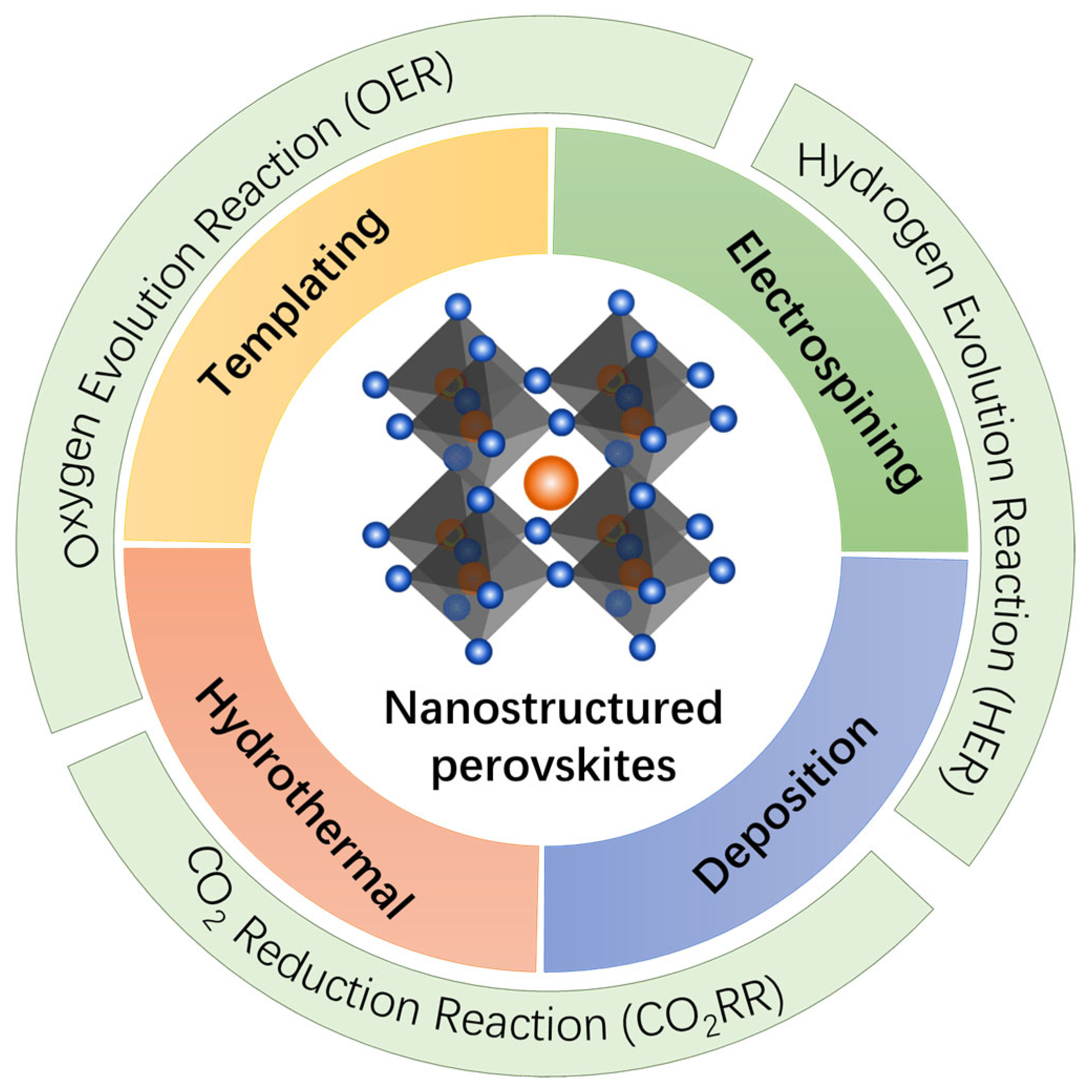
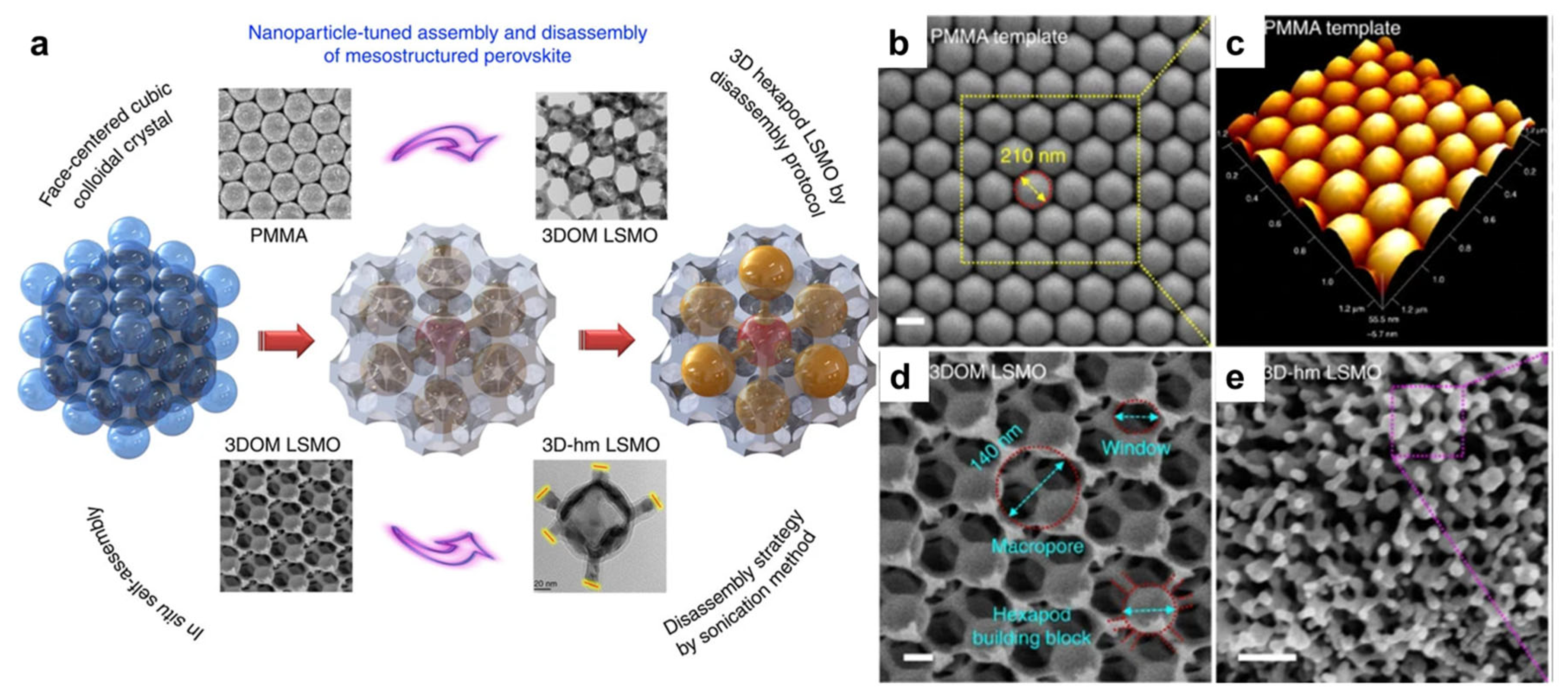
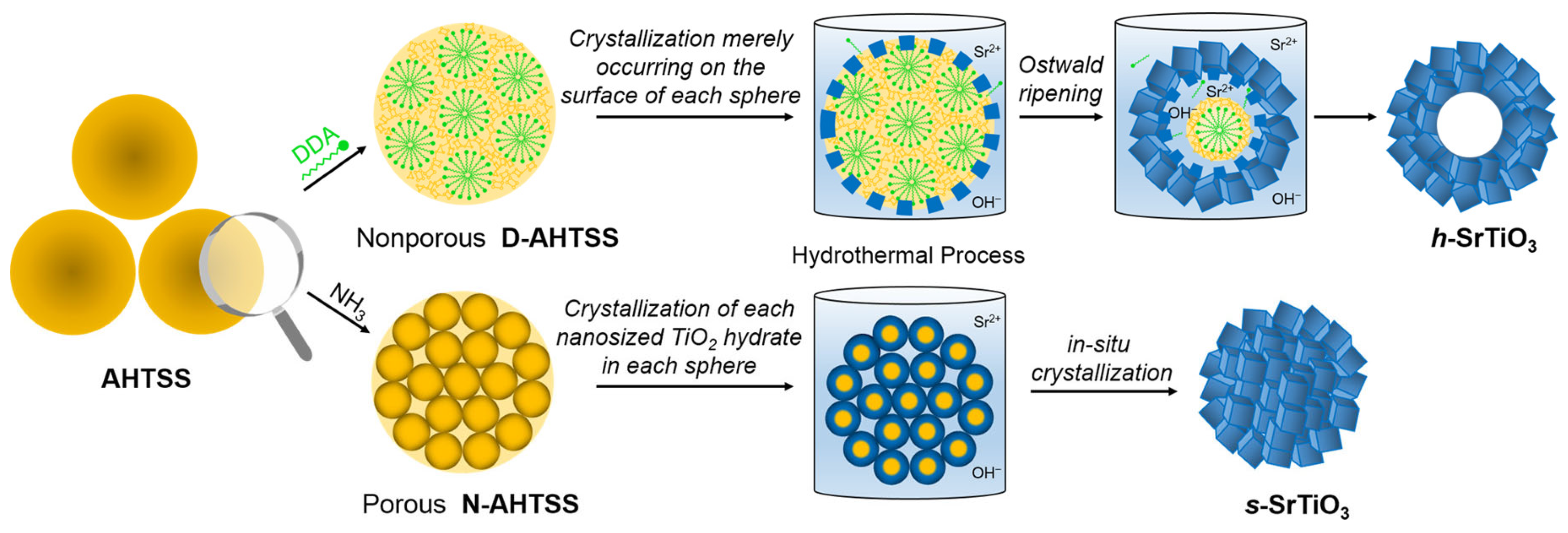
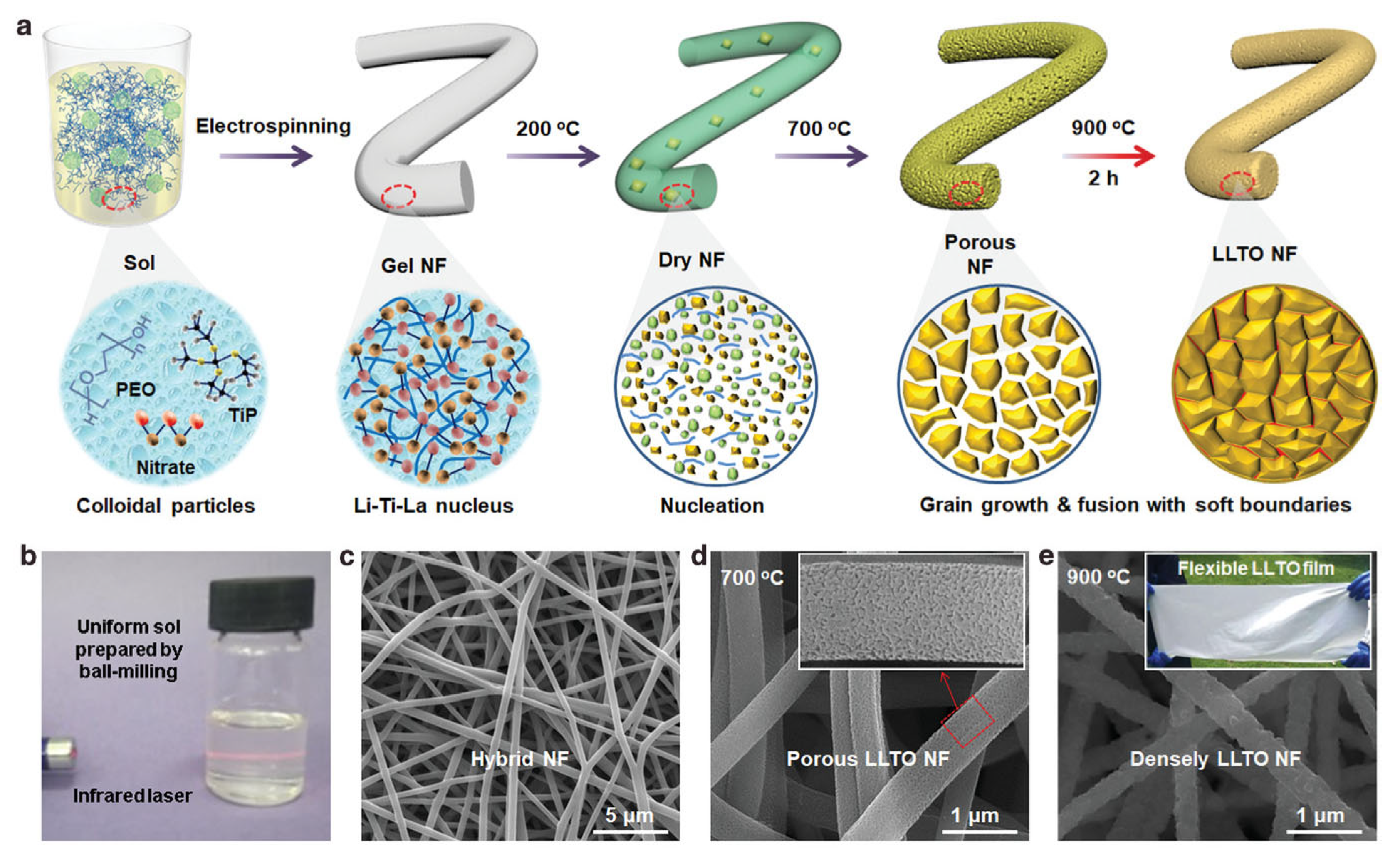
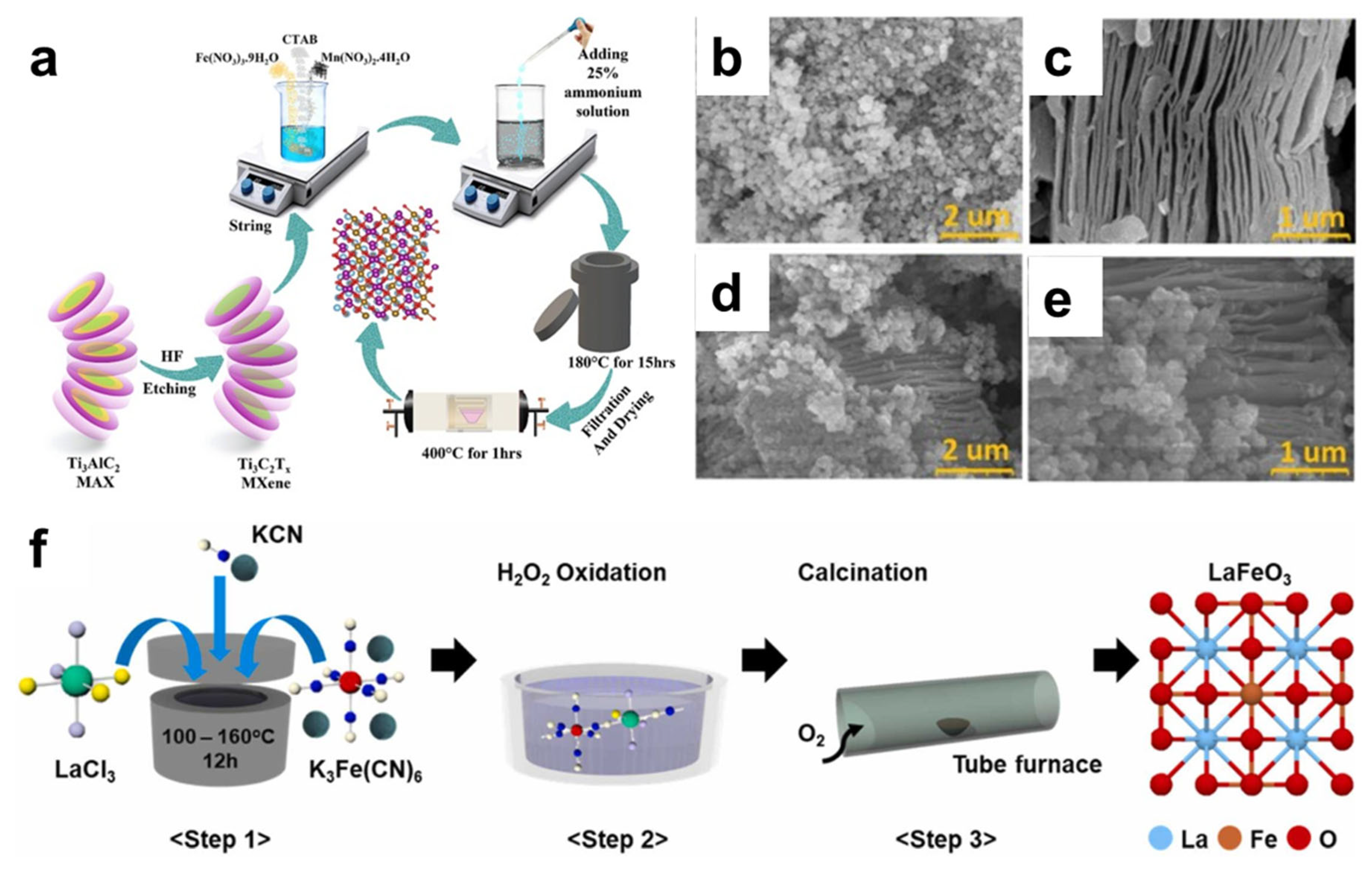

Disclaimer/Publisher’s Note: The statements, opinions and data contained in all publications are solely those of the individual author(s) and contributor(s) and not of MDPI and/or the editor(s). MDPI and/or the editor(s) disclaim responsibility for any injury to people or property resulting from any ideas, methods, instructions or products referred to in the content. |
© 2025 by the authors. Licensee MDPI, Basel, Switzerland. This article is an open access article distributed under the terms and conditions of the Creative Commons Attribution (CC BY) license (https://creativecommons.org/licenses/by/4.0/).
Share and Cite
Xue, X.; Li, B. Recent Advances in Nanostructured Perovskite Oxide Synthesis and Application for Electrocatalysis. Nanomaterials 2025, 15, 472. https://doi.org/10.3390/nano15060472
Xue X, Li B. Recent Advances in Nanostructured Perovskite Oxide Synthesis and Application for Electrocatalysis. Nanomaterials. 2025; 15(6):472. https://doi.org/10.3390/nano15060472
Chicago/Turabian StyleXue, Xiaofeng, and Bowen Li. 2025. "Recent Advances in Nanostructured Perovskite Oxide Synthesis and Application for Electrocatalysis" Nanomaterials 15, no. 6: 472. https://doi.org/10.3390/nano15060472
APA StyleXue, X., & Li, B. (2025). Recent Advances in Nanostructured Perovskite Oxide Synthesis and Application for Electrocatalysis. Nanomaterials, 15(6), 472. https://doi.org/10.3390/nano15060472






